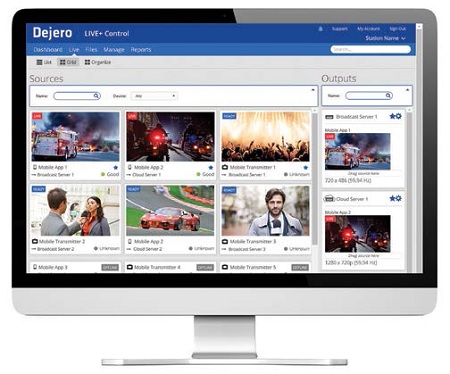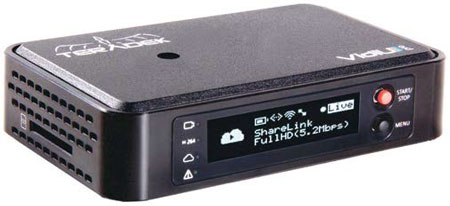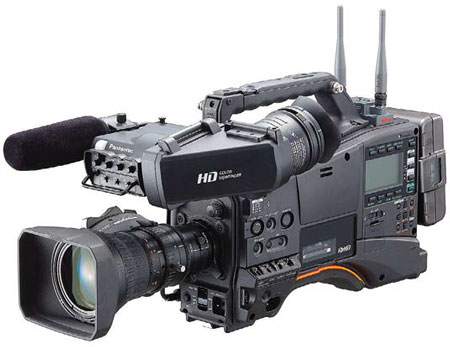Bonded Cellular Moves Beyond ENG
SEATTLE—I still remember a visit from a cellular phone company in the late 1990s to the affiliate where I worked, offering us liveshot capability over their wireless network.
I remember the images being black and white, a few frames a second with considerable delay, and resolution that made ATSC’s standard definition look like IMAX. And those liveshots, such as they were, were possible only if your news story happened within a narrow footprint of cellular signal coverage.
I remember we didn’t bite.
Cellular liveshots have come a long way since then. Camera makers targeting their wares at news departments are building cellular liveshot wherewithal in their equipment, and some companies that pioneered modern cellular liveshot technology are using cellular wireless for more than just transporting news stories.
“Our user behavior has moved way beyond its use as a newsgathering tool,” said Paul Shen, CEO of TVU Networks in Mountain View, Calif. “We’ve begun to see [this technology] used regularly as a transmission means for various different programs. That’s a fundamental paradigm shift.”
Shen said that the ability of his company’s system to regularly and reliably send 10 MBps over cellular networks gives customers confidence that complete programs can be transported without a hitch. “With our TVU Grid, we’re moving to TV studio operations, and looking to TV distribution, looking at how to share the content among TV stations.”
He assures that this is not to take away from a thriving business TVU Networks is doing with the its TVUPack liveshot gear.
Get the TV Tech Newsletter
The professional video industry's #1 source for news, trends and product and tech information. Sign up below.

Dejero Live+ Control Live+ Control is the company’s next-generation cloud-based management, monitoring, and reporting tool that simplifies IP video workflows used in remote broadcasting productions. Dejero Founder and Chief Technology Officer Bogdan Frusina noted that his company will continue to improve the reliability and quality of its cellular liveshot equipment that gets news stories from the field to the studio. “And as we have more and more of these assets in the field, you need to be able to manage them, get reports on them, get analysis on them.”
On a parallel track, the company has also tightened the integration of Dejero receive gear with Grass Valley’s GV Stratus video production and management system.
“We’re going to start working towards workflow integration and managing file-based workflow, from the field into the studio, and assuring that it is as seamless as possible for our users,” said Frusina. “We’re going to be able to enhance that ability to edit in the field and be able to move files quicker. That becomes very powerful, quicker to air, faster to air, delivering in multiple formats, delivering for the Web and for the studio as well.”
LOOKING FORWARD
Jon Landman, vice president of sales at Teradek in Irvine Calif., says it’s time to look at what’s next for cellular bonding technology.
“Bonding is no longer bleeding edge, it is accepted, everyone’s using it, there’s no magic in it,” he said. “So then you say to yourself, what’s the future of bonding?”
The company answered that question when it implemented the latest version of ShareLink, technology. “Until now there’s been no such thing as bonding for the masses,” Landman said. “[Because of the cost of sending data over cellular networks,] it’s pretty much been an exclusive kind of group of TV stations that get into the bonding game.”

Teradek’s VidiU Pro uses the company’s ShareLink technology maximize bandwidth and reliability by bonding multiple Internet connections from different sources. ShareLink allows the achievement of maximum bandwidth and reliability by bonding multiple Internet connections from different sources. It can combine a variety of interfaces, Ethernet, WiFi, USB modems, and even up to four iPhone cellular connections. “Anyone that streams, anyone that wants to move video from A to B is a potential customer for us,” Landman said. At the same time, Teradek continues to develop its bonded cellular technology around its Cube product.
All cellular liveshot systems utilize some form of compression, but not all of them use the same version of compression. According to Chris Crump, senior director of sales for Comrex in Devens, Mass., the version of H.264 Comrex implements “takes advantage of all the profiles within H.264’s specification. And so within our device, you can create a customized profile.”
He pointed to the advantage this brings. “So if you know you don’t want to do full HD, you could use a streamlined profile that would give you good SD at a certain bit-rate. But if you’re wanting to do full HD and you had more than enough bandwidth, you could use a six meg or eight meg profile.” Comrex supplies some profiles as a starting point, but Crump said customers frequently develop their own for specific challenges.
Avi Cohan, co-founder and chief operations officer of LiveU, said they’re “continuing to improve the video quality of our bonded cellular products. We’re going to improve the bootup time, and in the next year we have a lot of interesting stuff.”
But in addition, the company has undertaken the development of “some very tight integration with NewTek, which means LiveU is more tightly integrated with the NewTek switchers, both in the cloud and in the facility.”
Cohan said this allows LiveU to work with NewTek’s Network Device Interface protocol, which allows replacement of a SMPTE cable infrastructure with network cabling utilizing video over IP. “Let’s say that we’re out in the field and right now we’re covering some event, we send the video to the headquarters, and now the decoder gets it and takes it out through data cable over IP,” Cohan said. “In the NewTek switcher, you edit and add commercials, titles, whatever you’re doing with the video. And then send it out the appropriate channel.”
For a number of years, JVC has simplified cellular transmission by building the technology into its news camcorders, most lately in its GY-HM890 studio and field capable camcorders. The company also took on the challenge of working around congested cellular networks at large-crowd events with its Private MESH Video Network, which provides bandwidth up to 85 Mbps, significantly more than traditional cellular and bonded cellular transmission systems. Designed for single and multicamera shoots, the IP-based network solution combines JVC’s advanced camera encoding technology with the Silvus Bi-Directional Radio System to transmit very high quality HD video while avoiding bandwidth congestion issues from the use of public Wi-Fi or broadband networks.
Introducing the MESH network at the 2015 NAB Show, Dave Walton, JVC assistant vice president, marketing communications, said: “This is the future of ‘first mile’ contribution for live multicamera coverage of remote events. Broadcasters are going to love the reliability and simplicity of our private wireless network system, because it resolves any issues of access or bandwidth in the field.”
Walton said that sports producers expressed interest in the technology, and said it has huge potential for government and security applications as well.
Vislink, a long-time supplier of liveshot technology to broadcasters via its microwave and satellite products also offers cellular liveshot capability as well.
“We’re not a typical cellular equipment supplier, which are usually pure-play cellular liveshot vendors,” said Michael Payne, Vislink Communications president and chief technology officer. “We don’t just bond cellular channels together. We bond cellular and microwave, cellular with satellite, any combination. And we don’t force any one path back on the customer. If the customer is interested in the lowest cost path, which is usually microwave because they own that path, that’s what our system will give them. If they’re interested in the most flexibility to move around, that might be cellular.”
NETWORK INSIDE
The 2015 NAB Show saw Sony introduce network connectivity into many of its camcorders, allowing them to deliver video wirelessly through a cellular modem or over network data cables. Jeanne Lewis, marketing product manager for Sony Electronics Professional Solutions, pointed out that this not only allows delivery of video from the camera, but offers certain advantages because it’s a two-way data connection.
“One feature is that it allows the operator in the station to access many of the features in the camcorder. With the network built inside the camera, they have more features that you can access. For example, the operator at the station can access focus, zoom, or even the white balance.”

At the 2015 NAB Show, Panasonic launched the AJ-PX380 AVC-ULTRA shoulder-mount camcorder with integrated LiveU technology. Lewis noted that this is increasingly important with journalists becoming “one-man-band” video journalists, where the technical aspects of the camera were not part of their training. The VJ gets the camera on the tripod and turned on, “but he doesn’t know how to set up the camera,” she said. Back at the station a more technically oriented crew member can remotely access the camera, and make adjustments to optimize the pictures and signal.
Cellular connectivity went 4K this autumn at the IBC Show when Panasonic integrated LiveU technology into the AJ-PX380 AVC-ULTRA shoulder-mount camcorder. “[This supports] 4G/ LTE, wired LAN and wireless LAN connections, enabling on-site preview, streaming and uploading data to a server quickly and easily at low cost with a PC/Mac, tablet or smartphone,” said Steve Cooperman, senior product manager for Panasonic.
Alternatively, users can connect to the camera via Wi-Fi to control, add or edit metadata, view proxies, or watch live streaming for logging or monitoring.
“Unique to Panasonic’s live streaming protocol is a quality-of-service layer that rapidly and dynamically adjusts the bit-rate of the streaming signal to optimize the transmission speed as bandwidth of the cellular network changes,” Cooperman said.
The cellular liveshot technology is certainly omnipresent in the television news world, but shows no slowing down in developing new capabilities.
